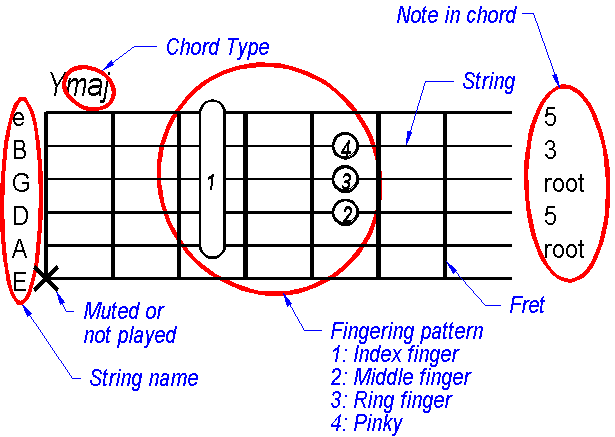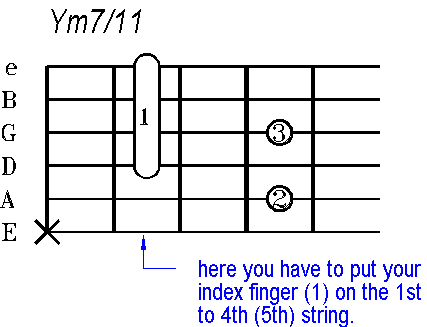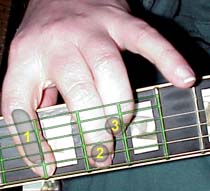

![[Previous Page]](prev_dis.gif)
![[Next Page]](next.gif)
![[Up]](up.gif)
![[Home Page]](home.gif)
![[Mail]](mail.gif)
![[Contents]](contents.gif)

One of the reason, I finally started creating this site was to provide some chord charts, that I have posted in FidoNet and the guitar newsgroups some years ago. Some people told me they liked the chord charts, so I wanted to make them permanently available on internet.
The chord charts I have put together don`t contain all the common chords everybody knows, but chords, that I call jazz chords - those chords with the numbers. They all contain higher chord options like the 7th, 6th etc. You will not find any plain major or minor chords in here. I have put the chordsinto a kind of lexical order to make them easier to find.
If you try them out, you should not play them distorted - they won't sound good this way and you may think, all of them are crap. The best way to try them is fingerpicking or playing with the thumb to achive a mellow sound.
All chords are as easy to transpose as bar chords - just shift the patterns up and down the fretboard.
IMHO the chords you find here are less straining, because you don't have to keep your index finger in that "bar chord position" all the time.
You can play about 600(!) different chords with the some 50 chord patterns in the chord charts. This way you don't have to learn too much by heart.
Here is a short description of the format of the chord charts:
Like I metioned before, all chords are as easy to transpose as bar chords. Thus they don't have a specific key - the "Y" is just a virtual key, it is variable, you can put a G, a Bb etc. instead. E.g. if a chord placed at the 3rd fret is a C major, just shift it down one fret, now you have a B major with the same pattern.


The numbers within the fingering pattern represent the fingers of your left hand.
An "X" the leftmost fret means that this string is muted or not played.
An "o" means an open string Ė I guess, I don`t make any use of it.
The  is just a location marker for a not played root note. It may help you to place the chord on the fretboard. You can leave out the root note of many chords without changing the feeling of the chord. Only minor chords don`t like that and start sounding majorish.
is just a location marker for a not played root note. It may help you to place the chord on the fretboard. You can leave out the root note of many chords without changing the feeling of the chord. Only minor chords don`t like that and start sounding majorish.
The 5th is not played in many cases, either. Only if it is a +5 or a b5 it adds some flavour to the chord. A plain 5th is contained in nearly every chord, it does not carry any further information, so it isnít vital.
The numbers on the right side of the fretboard represent the notes of the chord. E.g. "root" means the root note, "7" is the 7th ,maj7 is the major 7th, "min3" is the minor 3rd, "3" is the major 3rd.
To play a chord in a certain key, you have to know the notes of the (4th,) 5th and 6th string. Here is a map of the guitar freatboard:
is just a location marker for a not played root note. It may help you to place the chord on the fretboard. You can leave out the root note of many chords without changing the feeling of the chord. Only minor chords don`t like that and start sounding majorish.
The 5th is not played in many cases, either. Only if it is a +5 or a b5 it adds some flavour to the chord. A plain 5th is contained in nearly every chord, it does not carry any further information, so it isnít vital.
The numbers on the right side of the fretboard represent the notes of the chord. E.g. "root" means the root note, "7" is the 7th ,maj7 is the major 7th, "min3" is the minor 3rd, "3" is the major 3rd.
To play a chord in a certain key, you have to know the notes of the (4th,) 5th and 6th string. Here is a map of the guitar freatboard:

(Note: A F# is just the same as Gb, a C# = Db etc.)
The chords that are shown here have options like the 7th, a 9th... You might think, "What the heck is a ninth? I thought there were just 8 tones in a scale???"
No reason to panic... A 9th is one octave higher than a 2nd. A 2nd as a chord option is just a little bit unusual.
An 11th is a 4th plus an octave, a 13th is a 6th plus an octave and so on.
Some chords are "partial" bar chords. That means, you don't have to press a finger (I don't use only the index finger for that) on all six strings, but on maybe 2, 3 or 4. E.g.


All chords that are shown here are playable! They might be unusual to you in the beginning, but they arenít more difficult to learn than normal chords. Most are variations of just a few basic patterns, so when you are able to play some of the basic chords, the others will not be very hard to learn any more.

| [Next] | Major Chords |
| [Up] | Guitar chord charts |
| [Home] | Home Page |
| [Mail] | Send EMail to Sven's Guitar Site |
| [Contents] | Sven's Guitar Site Contents |

Last modified on Monday, 25. September 2017